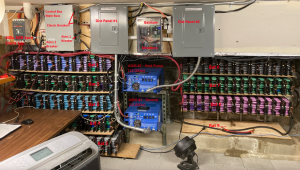Firstly, let me apologize for resurrecting this topic which has been discussed and beaten to death and that is the topic of building a large battery as opposed to a multiple smaller batteries and running them in parallel. In my scenario, I'm looking at 96 cells...lifepo4 with 280Ah cells which can make me a 6P16S...quite a large battery. I raised this question in this forum a few months back when I started this DIY solar journey and many persons seemed to recommend multiple smaller batteries than one large one. This got me to thinking why was that the case. Let me say early, I'm not trying to cheap out on buying multiple BMS-es. What I am trying to do is to avoid complexity in my battery build. I am also very concerned about multiple batteries in parallel and having to deal with inrush currents if I have to remove one of the batteries for some reason and when adding it back, it will potentially have a different SOC to the others which can cause the inrush.
They are BMS-es out there that can handle up to 500A max with relay with integrated active balancers to the tune of 2A to 5A and dedicated balancers up to 10A so balancing such a large bank shouldn't be too much of an issue assuming I'm starting out with all grade A cells and balanced properly to begin with.
Redundancy is not a major concern of mine as I will still maintain my connection to the grid and only use the grid as a backup. Plus, I also have a generator at the house as a last resort.
In terms of cabling for the large single battery, I'm looking at multiple cables in parallel to handle the current, including multiple parallel cables from the battery's main +ve and -ve terminals. I'm still doing some calculations on the battery's bus bar side of things but it's looking quite doable.
During my research over the last several weeks, I have not been able to find any scientific reason (outside of redundancy) why building a large battery as opposed to multiple smaller ones is a bad idea. Am I missing something? Would appreciate your comments and thanks in advance.
They are BMS-es out there that can handle up to 500A max with relay with integrated active balancers to the tune of 2A to 5A and dedicated balancers up to 10A so balancing such a large bank shouldn't be too much of an issue assuming I'm starting out with all grade A cells and balanced properly to begin with.
Redundancy is not a major concern of mine as I will still maintain my connection to the grid and only use the grid as a backup. Plus, I also have a generator at the house as a last resort.
In terms of cabling for the large single battery, I'm looking at multiple cables in parallel to handle the current, including multiple parallel cables from the battery's main +ve and -ve terminals. I'm still doing some calculations on the battery's bus bar side of things but it's looking quite doable.
During my research over the last several weeks, I have not been able to find any scientific reason (outside of redundancy) why building a large battery as opposed to multiple smaller ones is a bad idea. Am I missing something? Would appreciate your comments and thanks in advance.




